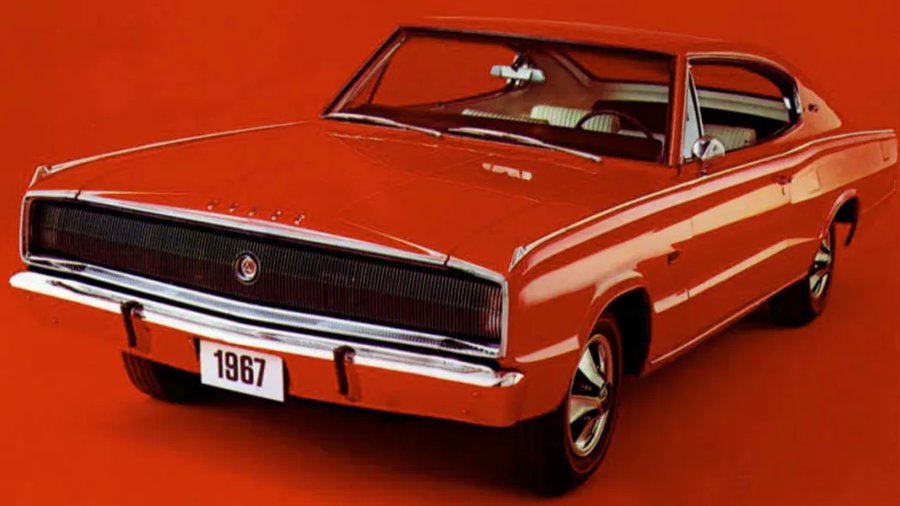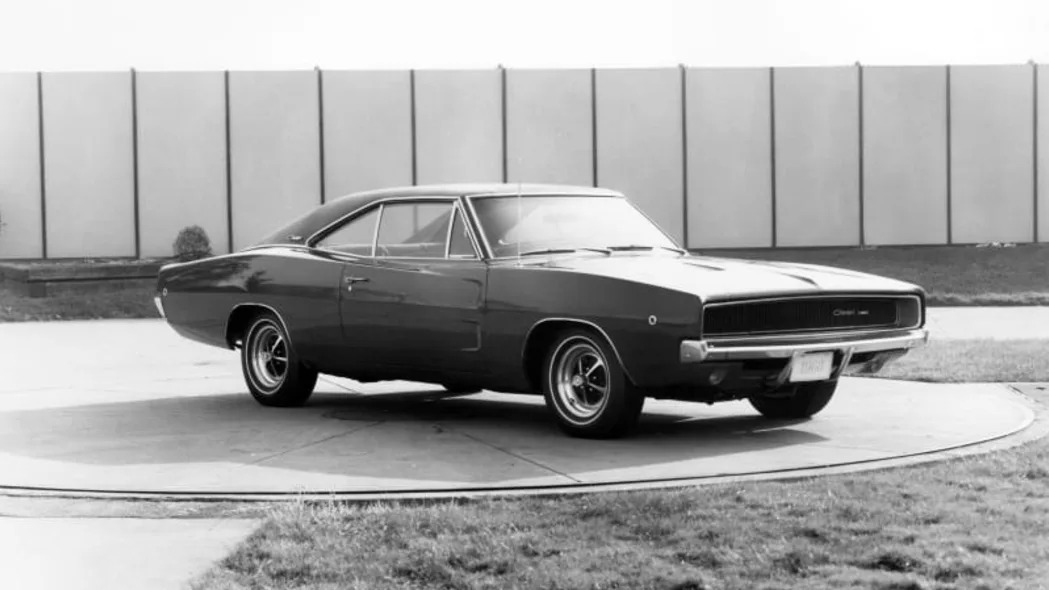Charging through history: A look back at Dodge's muscle sedan and coupe

No nameplate is more prominent in the annals of Dodge muscle car history than Charger. It’s survived through seven generations dating all the way back to the 1966 model year. While it’s true that in more recent times the Challenger has taken over as the quintessential muscular two-door offering, that car was initially developed as an answer to the massively popular and successful Ford Mustang. In other words, a pony car. It was the Charger that earned its stripes as the Mopar of choice on the stoplight-to-stoplight drags in towns all across America in the 1960s, lining up against venerable names like GTO, Chevelle, 442 and Torino.
The Charger also headlined Dodge’s efforts in stock car racing. The 1969 NASCAR season introduced the world to the Daytona name as Dodge became the first manufacturer to break 200 miles per hour on March 24, 1970, at Talladega in Alabama with Buddy Baker (as perfect a name for an American racer as we could hope to come up with) behind the wheel.
With apologies to Bob Dylan, well, the times they are a-changin’ for Dodge, which is finally joining the rest of the automotive world with a new version of the Charger that will, as ever, be focused on horsepower and performance. Only this time, it’ll be headlined by lithium-ion batteries and electric motors.
We’re all about looking forward, but there will always be a soft spot in our hearts for the good old days of internal combustion — especially when it came in helpings of 426 or 440 cubic inches topped with an assorted number of barrels. So let’s take a look at what got Dodge to this point and break down the first seven generations of the Dodge Charger as we anxiously await generation eight’s impending arrival.

First Generation Dodge Charger: 1966-1967
The first Charger seemed to split the difference between smaller pony cars like the Ford Mustang and larger luxury coupes like the Thunderbird (which had grown immensely in size over its first decade in production). The result was a fastback coupe with a luxurious interior highlighted by four bucket seats, a console that spanned all the way from the front to the rear and a sporty gauge cluster with glowing blue dials.
A series of V8 engines were offered for the Charger’s first generation ranging from 318 cubic inches to 440 cubic inches and topped in power by the barely streetable 426 cubic-inch Hemi V8’s 425 horsepower.
The first Charger looked aerodynamic with its sloping rear fastback roofline, and it pointed to a growing trend to make cars for the street that were designed to win races on high-speed tracks in America. How fortuitous...
Second Generation Dodge Charger: 1968-1970
This is the Dodge Charger that you’re most likely to think about when someone mentions the term “muscle car.” There are lots of reasons for that, from the coke-bottle styling that’s truly stood the test of time, to famous film and television roles that included Steve McQueen’s Bullitt and the Dukes of Hazzard.
Interestingly, though, this second Charger wasn’t quite as unique as its predecessor. Gone were the quad bucket seats and electroluminescent gauges, in their place more traditional mid-size car bits and pieces. And as much as we love this Charger’s shape, there’s no denying the fact that the “flying buttress” rear pillars were cribbed from the Pontiac GTO’s trend-setting design.
This is also the generation of Charger that led to the creation of the Daytona NASCAR competitor following earlier efforts with the Charger 500’s flush rear window. The sharply pointed face and massive rear wing were clearly designed for high-speed oval tracks, but still had to be offered to the general public in order to qualify for competition use. On the race track and on the street, it was the Plymouth Superbird that is ultimately remembered but the Charger Daytona came first. Only 503 Charger Daytonas were sold in the United States in 1969, the only year of production.

Third Generation Dodge Charger: 1971-1974
Federal regulators and the bean counters at insurance agencies may have signaled an end to the muscle car fun, but it’s really high gasoline prices that put the final nail into the high-horsepower coffin. Still, Dodge wasn’t ready to give up entirely.
The 1971 Dodge Charger was a radical departure from the second-generation car that preceded it. Like most cars of the era, it grew in size and took on a more bulbous look while leaning into Dodge’s 1970s-era colors, stripes and options packages.
The Hemi engine disappeared after the 1971 model year, and it took the imaginatively named Super Bee with it. They’d return eventually, but not until a few decades had passed. Net horsepower ratings meant rated figures were down, but the big 440 engine remained as torquey as ever.
An interesting historical sidenote: Even though this Charger ended production in 1975, the third-generation car continued competing in NASCAR for several more years. Dodge won the championship in 1975, led by Richard Petty. That was also the first year Dale Earnhardt would race, also in a Dodge Charger.

Fourth Generation Dodge Charger: 1975-1978
The 1975 Dodge Charger was a marked departure from the bulbous design of the previous version. It followed the trends of the time with lots of chrome, a large grille flanked by prominent headlights and, of course, a massive bumper designed to meet increasingly strict crash standards.
While its looks were new, the market it was targeting was basically the same. As a big coupe with big engine offerings, it was well positioned as a personal luxury coupe back when such things were sellable in the United States. Power was down (as it was across the entire industry) but V8s up to 400 cubic inches (or 6.6 liters if you prefer) were still on the menu.
The 1978 Charger marked the end of the nameplate on the rear-wheel-drive, body-on-frame B-body platform that traced its roots all the way back to the early 1960s, though the platform itself would carry on one more year in the form of the newly introduced Dodge Magnum and aging Chrysler Cordoba.

Fifth Generation Dodge Charger: 1982-1987
And now for something completely different. After a four-year hiatus, the Dodge Charger was reborn as an option package on the humble front-wheel-drive Omni platform. The Omni was designed in Europe and started life with small four-cylinder engines supplied by Volkswagen, but Dodge wanted something more American. The Omni 024 Coupe morphed into the Charger that those of us who grew up in the 1980s remember well. It got Chrysler’s 2.2-liter four-cylinder, which, while only initially producing 84 horsepower, was still an upgrade from the VW engine the platform started life with.
Carroll Shelby partnered up with Dodge to create an enhanced Charger wearing his well-known name and a bump to 107 hp, and it gained a turbocharger in 1985 to produce a respectable 146 hp before culminating in 1987 with the 2.2-liter Turbo II that spun out 175 hp and a matching 175 lb-ft of torque.
Although the Daytona name also reappeared in the 1980s — and also applied to a fastback coupe — the fifth-generation Dodge Charger was not on the same platform as the K-based Daytona. The Daytona, though, carried Dodge’s sporty reputation rather well as it continued in production until 1993 with as much as 224 hp from its 2.2-liter turbo four.

Sixth Generation Dodge Charger: 2006-2010
And now for something completely different, again. After disappearing for two decades, Dodge reintroduced the Charger nameplate for 2006. Only this time, it was used on a four-door sedan instead of a sportier coupe body design. Rather than reusing the seemingly natural Daytona name, Dodge reintroduced the famed Challenger nameplate on the shortened two-door version of the Charger’s new rear-wheel-drive LX platform, parts of which were derived from a previous Mercedes-Benz E-Class.
While its body style was different, the Charger was still about performance. Yes, there were Charger models aimed at style-conscious families with V6 engines, but the real action was at the top of the range and the reintroduction of the Hemi moniker. While the reborn Hemi didn’t share anything but its name with the vintage 426, it did produce a lot of power. It started at 5.7 liters and 340 hp and culminated in 6.1 liters and 425 ponies.
Dodge had lots of fun reliving its muscle car past with the new Charger sedan, reintroducing packages like R/T (Road/Track), Daytona and Super Bee along with retro colors that included Plum Crazy Purple, Top Banana and Go ManGo. The top dog, though, was new: the SRT8 debuted on this generation of the Dodge Charger, and those three letters would go on to define V8-powered performance for the next generation.

Seventh Generation Dodge Charger: 2011-2023
And this brings us up to date on the internal combustion side, as the overhauled Charger that debuted in 2011 on the rejiggered LD platform (a modified version of the previous LX) carried forward all the way until 2023. Dodge found a great deal of success as it positioned the Charger as the ultimate in American sedan performance.
The lineup starts with the well-regarded 3.6-liter Pentastar V6 engine with as much as 300 horsepower on tap, which ain’t bad. But the real fun starts with the R/T’s 5.7-liter Hemi V8 and its 370 hp. The 6.4-liter (or 392 cubic inches, as its name implies) SRT8, SRT 392 and Scat Pack was offered for those who believe there’s no replacement for displacement, spinning out between 470 and 485 naturally aspirated horsepower.
Though slightly smaller in size, the king of the hill in internal-combustion performance was the Dodge Charger SRT Hellcat. With its 6.2-liter Hemi engine supercharged to within an inch of its life and producing up to 797 hp in the Redeye variant (and a whopping 1,025 in the SRT Demon 170), the big rear-drive sedan could run from 0-60 in 3.4 seconds (assuming there’s enough traction) and go on to a top speed of 204 miles per hour.
Notícias Relacionadas
